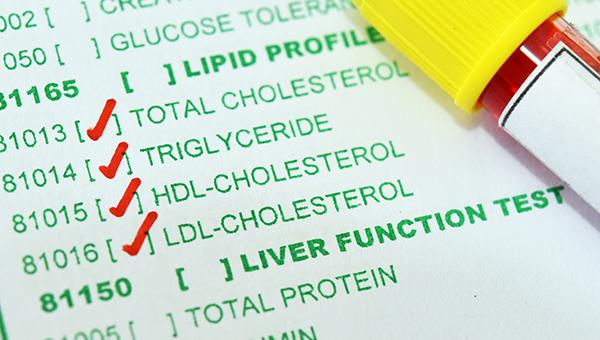Pelacarsen Targets Lp(a), With Little Impact on LDL Cholesterol
A new method of distinguishing Lp(a) in blood samples has implications for LDL tests and patient care, researchers say.

Pelacarsen, once known as AKCEA-APO(a)-LRX, is an investigational agent aimed at lowering Lp(a), but previous studies suggested it might also cut LDL cholesterol and apolipoprotein B-100, a finding that confused researchers because the drug, which targets hepatic LPA messenger RNA, has no known effects on apoB in the liver.
“When you think about how pelacarsen works, it shouldn’t affect LDL cholesterol to a great extent,” senior investigator Sotirios Tsimikas, MD (University of California, San Diego), told TCTMD. “What we noticed in prior studies and in the phase II study is that there was more LDL cholesterol-lowering than we would have predicted.”
In some of those early reports, pelacarsen lowered LDL cholesterol by roughly 25%, and apoB by 16%, when used at the highest doses. Given the drug’s mechanism of action, researchers were uncertain if the changes in LDL cholesterol were a real physiological effect or simply because laboratory measurements of LDL cholesterol include both true LDL cholesterol and Lp(a)-associated cholesterol. For example, a patient with LDL cholesterol of 70 mg/dL, depending on the concentration of Lp(a), might only have a true LDL-cholesterol concentration of 60 mg/dL or possibly even lower levels.
“That number will change depending on the Lp(a) concentration—the higher Lp(a) is, the more Lp(a) cholesterol is going to contribute to the LDL-cholesterol value,” said Tsimikas. “With high Lp(a), you tend to have lower LDL cholesterol than what is anticipated. If you’re thinking about therapeutic ways to affect LDL cholesterol, if somebody has a very large amount of Lp(a), then LDL cholesterol might be very unresponsive to treatment.”
Lp(a) has been shown to be a risk factor for CVD, both in primary- and secondary-prevention settings, as well in mendelian randomization studies. In the US guidelines for the treatment of high cholesterol, elevated Lp(a) is considered a risk-enhancing factor to help physicians and patients make an informed decision about LDL cholesterol-lowering treatment. In Europe, the clinical guidelines recommend checking Lp(a) for CVD risk stratification in individuals at least once during the patient’s lifetime, although the recommendation is relatively weak.
At present, there are no approved drugs for lowering Lp(a), but the Lp(a)HORIZON study with pelacarsen is currently ongoing. Other RNA-based therapies also are in development.
Accurately Measuring LDL Cholesterol
The goal of the present study, led by Calvin Yeang, MD (University of California, San Diego), and published this week in the Journal of the American College of Cardiology, was to validate an accurate way to measure LDL cholesterol and to tease out the actual effect of pelacarsen on both LDL and Lp(a) cholesterol. For the studies, Yeang and colleagues used a new method for directly measuring Lp(a) cholesterol in the plasma, a process that involves isolating the Lp(a) particles using monoclonal LPA4-conjugated magnetic beads so that the Lp(a) cholesterol can be quantified. Once the Lp(a) is known, it’s subtracted from laboratory-derived LDL cholesterol in order to determine the “true” value of LDL cholesterol.
The study population was comprised of 286 patients participating in the dose-ranging AKCEA-APO(a)-LRX study, all of whom had elevated levels of Lp(a)—defined as > 60 mg/dL—and established cardiovascular disease. Researchers using the novel extraction and subtraction methodology found that the amount of Lp(a) cholesterol in plasma was actually quite high, ranging from 11.9 to 15.6 mg/dL. For the patients in the trial, all of whom had laboratory assessed LDL-cholesterol levels ranging from 68.5 to 89.6 mg/dL, that meant their “true” LDL cholesterol was actually between 55 to 74 mg/dL, said Tsimikas.
Across the range of pelacarsen doses, Lp(a)-cholesterol levels were reduced by 28.9% to 66.7%. That finding isn’t surprising, said Tsimikas, since pelacarsen is reducing Lp(a) that carries Lp(a) cholesterol. With respect to LDL cholesterol, when using the laboratory assessed measurement, pelacarsen lowered it by as much as 26%. However, when LDL cholesterol was corrected to account for Lp(a) cholesterol, pelacarsen’s effect on LDL was significantly attenuated.
“The corrected method is the most accurate—when you use the lab LDL, it looks like there could be to a 20% or so reduction in LDL with pelacarsen, but that’s a false number because it includes the Lp(a) cholesterol,” said Tsimikas. “If you use the corrected method, the reduction is much more modest.”
Additionally, Tsimikas said their data showed that the Dahlén formula, a method that accounts for the Lp(a)-associated cholesterol by subtracting a set percentage, is inaccurate. In their study, correcting LDL cholesterol using the formula seemed to suggest that pelacarsen increased LDL levels, but that’s a spurious finding, said Tsimikas, noting that the formula has never been validated.
Clinical Implications
Tsimikas believes laboratories need to consider changing how they measure lipids, saying that they should begin to consider Lp(a)-cholesterol levels as independent variables, while also understanding how these might skew standard LDL-cholesterol measurements. This could have important consequences for treatment. For example, an ACS patient with an LDL level of 78 mg/dL would have treatment intensified with statins, ezetimibe, or a PCSK9 inhibitor, but if they have a very high Lp(a) concentration, the “real” LDL cholesterol might already be sufficiently controlled.
“Yes, you could give them a stronger statin and lower the LDL down to 40 to 30 mg/dL, but you’re not addressing the real risk,” he said. “We need to determine where the cholesterol is, and make sure we do more of a personalized medicine approach to treat the patient’s residual risk, rather than just using the LDL cholesterol from the laboratory that doesn’t differentiate Lp(a) cholesterol from LDL cholesterol.”
In an editorial, Guillaume Paré, MD, Michael Chong, PhD, and Pedrum Mohammadi-Shemirami, BSc (all McMaster University/Population Health Research Institute, Hamilton, Canada), write the study shows that the contribution of Lp(a) to LDL cholesterol is not negligible using standard assays and confirm that the effect of pelacarsen is likely most confined to Lp(a).
Paré and colleagues highlight some limitations of the new study, pointing out that the population included patients selected on the basis of having high Lp(a). While the findings are likely to be applicable to the general population, “the confounding effect of elevated Lp(a) on LDL cholesterol can nonetheless be expected to be smaller, or even negligible, in patients with normal or low Lp(a) through either natural or pharmacological means.”
“In other words,” they add, “if and when Lp(a) becomes a therapeutic target, residual Lp(a) might not be high enough to have a material effect on LDL-cholesterol measurements, even with current methods.” They also note that the assay is novel, and likely to be expensive given the additional steps needed to tease our Lp(a) cholesterol from LDL measurements. Still, Paré and colleagues agree that “with the impending introduction of Lp(a) into clinical practice,” the issue will become more relevant for physicians.
Michael O’Riordan is the Managing Editor for TCTMD. He completed his undergraduate degrees at Queen’s University in Kingston, ON, and…
Read Full BioSources
Yeang C, Karwatowska-Prokopczuk E, Su F, et al. Effect of pelacarsen on lipoprotein(a) and corrected low-density lipoprotein cholesterol. J Am Coll Cardiol. 2022;79:1035-1046.
Paré G, Chong M, Mohammadi-Shemirani P. Lipoprotein(a) cholesterol masquerading as low-density lipoprotein cholesterol: catch me if you can. J Am Coll Cardiol. 2022;79:1047-1049.
Disclosures
- Tsimikas is an employee of the University of California, San Diego (UCSD) and Ionis Pharmaceuticals. Direct measurement of Lp(a) in the study was funded by a research grant to Tsimikas through UCSD. Tsimikas is a coinventor and receives royalties from patents owned by UCSD on oxidation-specific antibodies and biomarkers related to oxidized lipoproteins. He is a cofounder and has equity interest in Oxitope and Kleanthi Diagnostics. He is also a cofounder of Covicept Therapeutics and reports research support from Fondation Leducq.
- Paré reports receiving honoraria from Amgen.





Comments